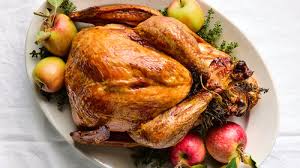Dry brining turkey is an effective technique to improve flavor and achieve moist, tender meat. This method entails applying a blend of salt, herbs, and spices to the turkey, followed by refrigerating it uncovered for a period ranging from 24 to 72 hours. The process extracts moisture from the turkey, allowing the salt to dissolve and subsequently be reabsorbed, which enhances the seasoning throughout the meat and improves its texture. Additionally, dry brining contributes to a beautifully crisp skin when the turkey is roasted.

1.Comprehending the Mechanism of Dry Brining
Dry brining turkey operates through the principle of osmosis. When salt is applied to the turkey, it initially extracts moisture from the meat. This moisture combines with the salt and any additional seasonings, forming a brine solution. Over time, the turkey absorbs this liquid back, allowing the salt to penetrate the meat. The protein fibers in the turkey are slightly broken down, which aids in moisture retention during the roasting process.
While salt draws moisture out, the turkey subsequently reabsorbs both the moisture and the flavors, resulting in a tender and juicy outcome. The process also benefits the skin: the salt helps to dry it out, leading to a crispy exterior upon cooking.
2.The Advantages of Dry Brining for Turkey
Turkey is prone to drying out, particularly the lean breast meat. Dry brining addresses this issue by:
– Ensuring even and deep seasoning: The salt and spices permeate the meat, providing seasoning throughout rather than just on the surface.
– Enhancing juiciness: The moisture retained from the brine contributes to a significantly juicier turkey.
– Promoting crispier skin: The drying effect on the skin encourages it to become crisp during the cooking process.
In contrast to wet brining, which can dilute flavor, dry brining amplifies flavor and guarantees a superior texture.
3.Essential Ingredients and Their Functions
Kosher Salt
Kosher salt is preferred over table salt due to its larger crystals, which dissolve more slowly and uniformly. This characteristic helps prevent the turkey from becoming overly salty, a frequent problem associated with standard table salt.
Measurement guideline: Use 1 tablespoon of kosher salt for every 5 pounds of turkey. If opting for table salt, reduce the quantity to 3⁄4 of the kosher salt measurement, as it is more compact.
Sugar (Optional)
While sugar is not mandatory, it contributes a hint of sweetness and promotes even browning of the skin. Brown sugar imparts a deeper flavor with caramel undertones, whereas white sugar offers a more straightforward sweetness.
Herbs and Spices
Incorporating fresh or dried herbs and spices enhances the flavor profile of both the meat and skin. Recommended options include:
Herbs: Rosemary, thyme, sage, oregano, bay leaves.
Spices: Black pepper, garlic powder, onion powder, smoked paprika, and cayenne pepper for a bit of heat.
Additionally, citrus zest (from lemon, orange, or lime) can be included for a vibrant, aromatic touch. The primary role of salt is to elevate and balance the turkey’s inherent flavors, while other spices contribute complexity.
4.Procedure for Applying the Dry Brine
Step-by-Step Process
Prepare the Turkey:
Begin by removing the giblets and thoroughly drying the turkey with paper towels. This step is vital for achieving a crispy skin, as any moisture on the surface will hinder crisping.
Mix the Dry Brine:
In a small bowl, blend kosher salt, sugar (if included), and your selected herbs and spices.
Season the Turkey:
Apply beneath the skin: Carefully lift the skin away from the meat, particularly on the breast and thighs, and massage the dry brine mixture underneath. This method ensures that the seasoning penetrates the meat effectively.
Season the exterior: Rub the remaining brine onto the outer skin, covering the legs and wings as well.
Refrigerate Uncovered:
Position the brined turkey on a wire rack placed in a roasting pan or baking sheet. It is important not to cover it. The turkey will expel moisture and subsequently reabsorb it; allowing for air circulation will assist in drying the skin, resulting in a crisp texture when roasted.
5.Dry Brining Duration
Minimum of 12 hours: It is essential for the turkey to undergo a minimum of 12 hours of dry brining for the salt to effectively penetrate. However, a duration of 24 to 48 hours is recommended for optimal results.
Extended duration is preferable: For a more pronounced flavor, aim for a complete 48 hours of dry brining. Nevertheless, a period of 12 to 24 hours will still produce a flavorful turkey.
Dry Brining Duration Based on Turkey Size:
Up to 12 lbs: 12-24 hours
12-20 lbs: 24-36 hours
Over 20 lbs: 36-48 hours
6.Important Considerations for Dry Brining
1 (Butterflying the Turkey)
A entails the removal of the turkey’s backbone, allowing it to be flattened. This technique promotes even cooking and enhances skin crispiness.
For dry brining: After a season both the breast and the underside of the turkey. This approach ensures crispy skin on both sides.
2.Whole Turkey versus Parts
When dealing with turkey parts (such as the breast, thighs, or wings): The same brining principles apply, but the duration is shorter. Brining for parts may only require 4-8 hours, depending on the size of the individual pieces.
3.Frozen Turkey
If beginning with a frozen turkey, it should be thawed in the refrigerator for 1-2 days prior to applying the dry brine. Ensuring the turkey is completely thawed is crucial for even brining.
7.Common Pitfalls to Avoid
Excessive salt: While salt is a key ingredient, overuse can lead to an overly salty turkey. Adhere to the recommended measurements and avoid excessive application.
Covering the turkey during refrigeration: Covering the turkey traps moisture, hindering the skin from drying out. It is advisable to leave it uncovered in the refrigerator.
Rinsing the turkey: After applying the brine, refrain from rinsing the turkey, as this will wash away the seasoning. Instead, gently pat off any excess brine with paper towels before cooking.
Neglecting the resting period: Do not overlook the importance of allowing the turkey to rest after cooking. A resting period of at least 20-30 minutes is necessary for the juices to redistribute.
8.Roasting the Dry Brined Turkey
Begin by preheating your oven to 325°F (165°C). For a more pronounced crispiness of the skin, you may opt to raise the temperature to 375°F (190°C), although 325°F is the recommended setting for uniform cooking.
Cook the turkey for roughly 13 minutes per pound, or until the internal temperature reaches 160°F (71°C) at the thickest section of the breast. A meat thermometer is essential for verifying that the turkey is fully cooked.
To achieve a crispy skin: Consider increasing the oven temperature to 400°F (205°C) during the final 30 minutes of the cooking process.
Optional Basting: For an additional layer of golden skin, you may baste the turkey with melted butter or oil. This step is not necessary, as the dry brine effectively maintains the skin’s crispiness on its own.
Monitor the internal temperature: The breast should reach 160°F (71°C), while the thigh should be at 175°F (80°C).
9.Resting and Carving
After the turkey has finished cooking:
Allow it to rest for 20-30 minutes. This resting period enables the juices to redistribute, ensuring the meat remains moist when carved.
Proceed to carve the turkey and savor the tender, juicy meat accompanied by the crispy skin.
10.Advanced Variations for Extra Flavor
Herb-Infused Dry Brine: Incorporate crushed garlic, shallots, or fresh herbs such as thyme, rosemary, and bay leaves into your dry brine mixture. This will impart aromatic flavors to the turkey.
Citrus Dry Brine: Blend lemon, orange, or lime zest into your brine for a refreshing citrus flavor.
Smoked Salt: For a deeper, smokier taste, consider replacing some or all of the kosher salt with smoked salt.
Spicy Dry Brine: Introduce chili powder, cayenne, or crushed red pepper flakes to add a touch of heat.


